[Update: It’s February 15, a week later, and we’ve just had more snow! I’ve updated my report below, underlining major additions, and done light editing. For another view of the crisis, see my post here about how Beijing’s bar and restaurant scene is being crushed, with many venues down 80 percent or more in revenue. Plus these photos of empty streets and malls. Find this content useful? Support the site!]
A peaceful scene in Beijing this week as snow slowly fell for two days: big fat luxurious flakes lazily corkscrewing to empty sidewalks and streets. A jarring juxtaposition with my flooded social media feed, where self-quarantined friends posted steady streams of updates on the coronavirus crisis.
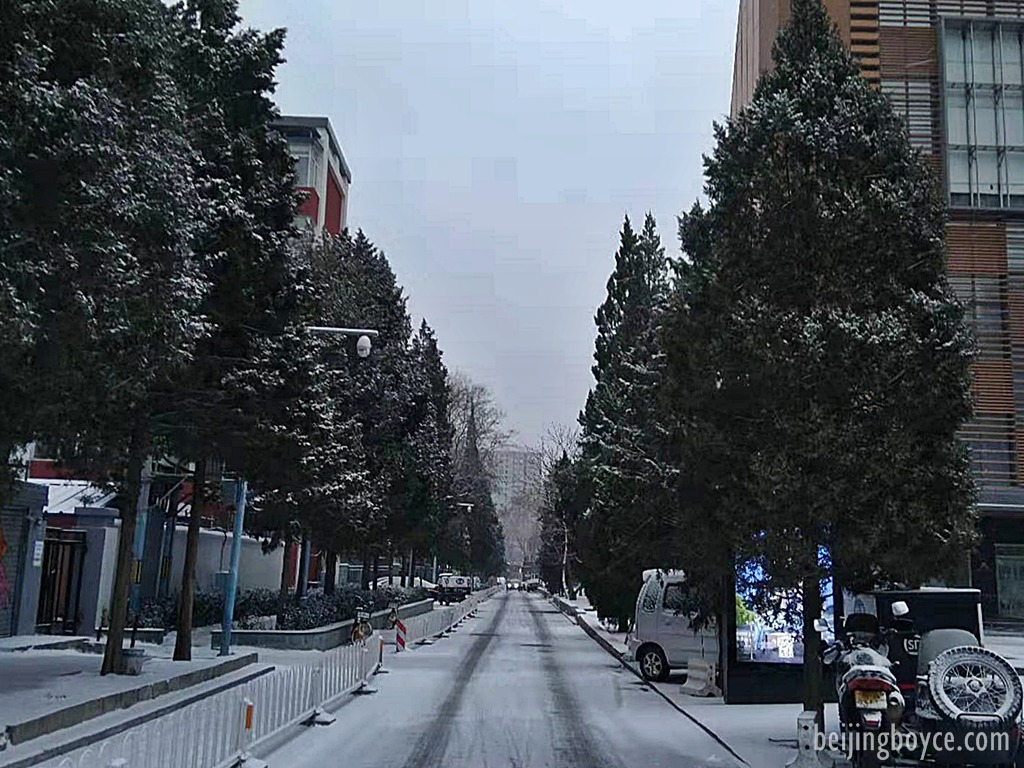
The last week saw more measures to fight the viral spread, more business go into limbo, more airlines slash routes to and from China, more people flee or be evacuated, more restrictions at housing compounds, malls, bars and restaurants, and–most critically–more infections and deaths.
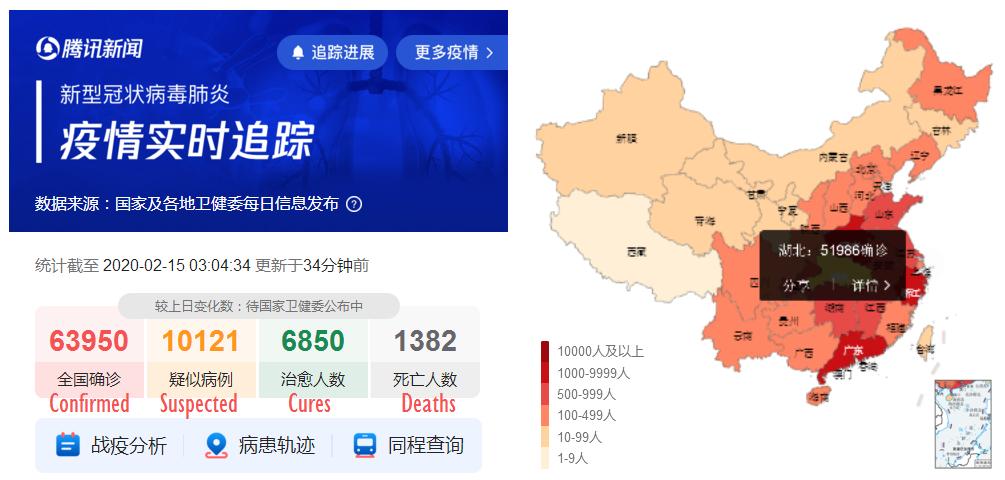
The official China numbers are 63,950 infected, 10,121 suspected and 1382 deaths, the vast majority in Hubei province, the epidemic’s epicenter. The actual number is hard to say, as we still don’t know the full details of this virus and Hubei’s healthcare system is overwhelmed. But we know some of the effects.
Hundreds of millions self-quarantined up to three weeks now. Employees stuck in their hometowns since the New Year, unable to return to work in their adopted cities. Some Beijing restaurants / bars report 70 percent, 90 percent, even 100 percent of employees have not yet come back. People slip on masks for market trips to stockpile supplies, then spend hour after hour on WeChat reading updates and messaging friends and family who are quarantined elsewhere.
It’s quiet outside. Yesterday, I went out for lunch, my first restaurant meal in 24 days, in the usually bustling Sanlitun area. It was a ghost town.

I found the same scene ten days earlier at the crossing of Worker Stadium North and Sanlitun South streets, usually a guarantee of blood pressure-inducing chaos, with hundreds of pedestrians weaving around cars nosed over crosswalks, and delivery scooters zipping everywhere. Here’s what it looked like at 6 PM:
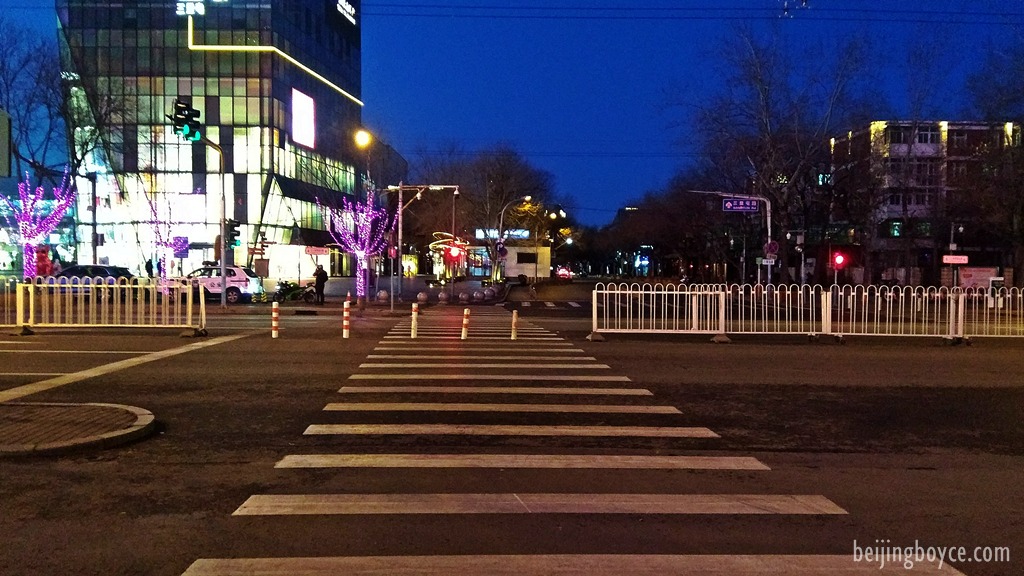
This situation is obviously hitting the wine trade, too. With initial hopes everything might be fine by the end of Chinese New Year now long gone, things look worse and worse. Ten examples of the impact.
1. No entry
Winery and sales reps, wine critics and writers, consulting winemakers and viticulturalists et al won’t be heading our way in the near future. A blend of slashed flights to / from China, quarantine rules and, of course, the virus threat make that all but impossible.
For example, anyone planning to visit from the U.S. will find key airlines cut flights to mainland China: American (until March 27), United (March 28) and Delta (April 30). Returning US citizens face screening at a “select number of ports of entry†and up 14 days of “monitored self-quarantine.” (Been to Hubei? It’s up to 14 days mandatory quarantine.) For foreigners who are not immediate family of a U.S. citizen / permanent resident, entry is denied if you’ve been in China the past 14 days. A friend was just in this situation.
It works both ways, with all visitors to Beijing now facing two weeks of time to themselves. From Reuters: “… Beijing is imposing a 14-day self-quarantine on all those returning to the city, and will punish those who refuse to quarantine themselves or follow official rules on containing a new coronavirus, city authorities said on Friday.
Rules are tightening in housing compounds, too. My compound added a guard over a week ago to ensure only residents enter. Those ordering food delivery must meet the driver at the main gate. During the past few days, we have also been given cards to show upon entering and must do temperature checks.
2. No exit
Likewise, travel restrictions severely impact Chinese going abroad. That includes tourists. At Australian wineries, Chinese were the top source of international visits last year, while in Napa Valley they were second in 2018. Far fewer tourists from China will have a global impact, including on wineries.
It’s hardly just tourists affected. It also affects Chinese returning to wine-related disciplines at overseas schools, attending international trade fairs as buyers, sellers, speakers and writers, working or interning at wineries overseas, and more. How many people in China who had plans to attend Wine Paris, starting on Monday, will actually make it there?
(It seems not many. I talked to Richard Li, president of wineries DFC and Canaan and formerly at ASC, who attended the show. “I was one of the few [mainland Chinese] in the whole exhibition area,” he said. Li had not intended to go but got stranded in Paris when Air France canceled China flights due to the virus situation.)
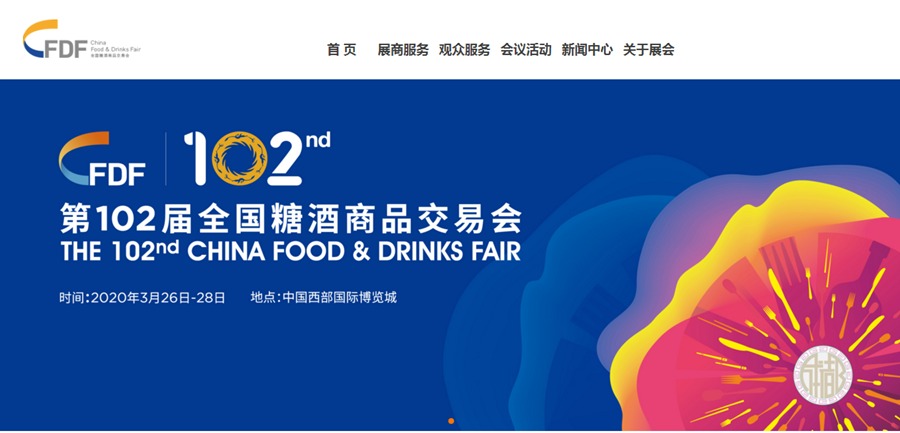
3. No fair
Trade events are being cancelled or postponed. The biggest is Chengdu’s annual China Food & Drinks Fair, said to total 3,000 exhibitors, 300,000 visitors and RMB20 / USD3 billion in deals. It’s where the wine trade finds potential clients, catches up with old ones, learns of new products and gets a sense of the state of the industry. Sprawling and chaotic, and often inspiring over-the-top boozing, it’s postponed indefinitely.
Because of the fair’s size, the logistics of a changed date are a nightmare. And because normalcy is unlikely to return until late April / early May at earliest, so is the timing, as that is a far busier period for the trade than late March. Any later and the spring CFDF, always in Chengdu, comes too close to the fall fair, which rotates around China.
Other big events, including those to promote Rioja and wines of South France, have also been postponed.
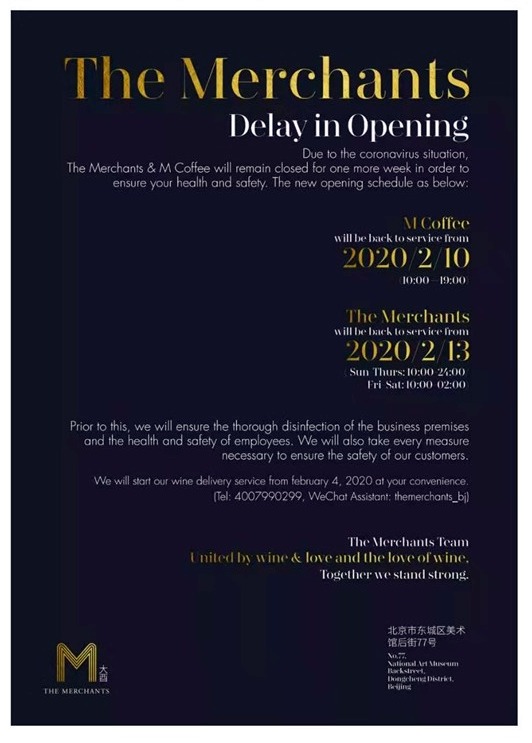
4. Sorry, we’re closed
From thousands of Starbucks branches and hundreds of Haidilao hotpot outlets to smaller chains and standalone venues, we see many darkened doors. Beijing Evening News reported that just 13 percent of the city’s 87,000 food venues remain open during the coronavirus crisis. Global Times pegged national catering sector losses at USD72 billion, as 93% of restaurants shut for the Chinese New Year break.
This [last] week, I talked to three of my favorite Beijing wine bars. All have delayed their re-openings, citing public safety, with current dates of February 10 to February 13. The owner of Italian wine bar Buona Bocca also said it was a matter of human resources. Most of her team hasn’t returned yet, though she has been able to open next-door mala tang restaurant Mala Bocca.
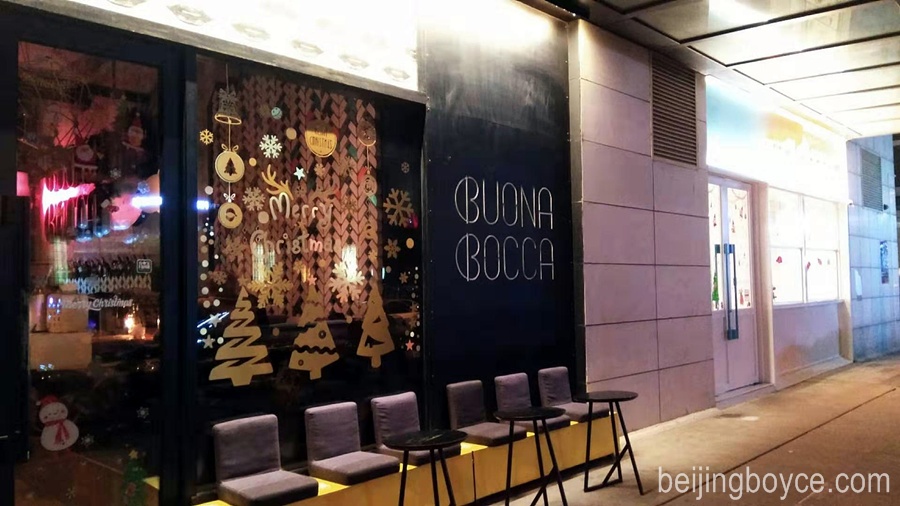
Tapas and wine bar Vinvino had planned to reopen February 3 but is now aiming for February 10. “I’m not sure what’s going to happen, to be honest,” a co-owner told me. “I just hope things will get back to normal soon.”
That might take some time, as the owner of The Merchants wine bar and restaurant told me. She, too, had to delay reopening, from February 3 to February 13. (The cafe part of her venue is slated for February 10.) But even when the restaurant and bar scene is back online, the coronavirus crisis impact will linger.
“I think it will heavily impact us and many other restaurants and bars. I think in general people will be afraid to go out,” she said in this piece I wrote for Meininger’s.
All of these wine bars have reopened during the past three days, through VinVino and The Merchants have reduced hours. Both Buona Bocca and The Merchants have promoted delivery, since being open is no guarantee of customers these days.
Some bars and restaurants in my neighborhood remain open. I’ve been home the past two weeks save for market visits and one night out, when I visited Hulu, a restaurant where reservations are generally advised. A friend and I were the sole happy hour customers, with several tables trickling in later. Our second stop, pub Groovy Schiller’s had a light scattering of patrons, most regulars. To generate revenue, and cover Beijing’s sky high rent, more venues are adding or upgrading delivery, including for wine.
I also went to Hulu on Wednesday for lunch, my first meal out in 24 days. The venue was about half full, although it should be noted that with few other restaurants open, people are want to congregate at those that are. There are options–the local Red Lobster and the Bad Farmer bakery, among others–but it was generally ghostly. The B1 level of TopWin Center that sees a bustling lunch crowd due to office workers nearby had only a few places open, including Avocado Tree and the imported foods shop April Gourmet.

5. Three’s a crowd, er, group?
Beijing’s authorities have banned group dining such as company, school, birthday and wedding gatherings. A major portion of wine sales are tied to such entertaining will hurt many brands. It might be especially painful for the growing number of quality local wine brands, who have been far more successful at winning awards than inspiring sales. Without a few tricks up their sleeves, times are looking even tougher.
In terms of group dining, the rule now seems to be no more than three customers per table–and at least one meter between tables–totaling less than half of the venue’s capacity. One wine bar owner posted that “we cannot accept any group dinners, only (tables for) one to two people.†More here.
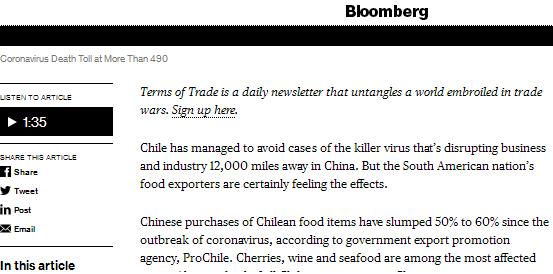
6. Local Customs
A Chilean wine importer told me last week he estimates his shipment is stuck in Customs until February 10 at earliest. The bigger picture of his country’s situation is provided by Bloomberg:
“Besides the plunge in orders, about 1,400 containers carrying Chilean food and wine are waiting to unload in Chinese ports, [Jorge] O’Ryan [of government export promotion agency ProChile] said.
“Authorities there are accepting 40 to 50 containers a day from Chile, compared with 200 to 350 normally.”
7. Sinking sales
Retailers, distributors et al are expecting major sales hits. Torres China’s managing partner projects an 80% drop for February and 50%-plus for March. One wine shop tells me less than half of their shops are open and sales at those are low. Others confirm dire sales numbers and expect no relief until late April or early May at the earliest.
A wine marketing expert from China Agricultural University, says she expects many in the trade to go into survival mode: to refocus on old customers and proven sales, tighten operations and get stricter about cash flows.
8. Staff outing
Some staff who returned to their hometowns for New Year’s holidays are currently unable to get back to their cities. Many of those returning face up to two weeks of self-quarantine at home. (The authorities announced yesterday that all those entering Beijing must be quarantined, either self-administered or otherwise, for two weeks.) For some, there is no office to go to anyway as shared spaces have delayed reopening. (February 10 was supposed to be a back-to-work turning point but many spaces / businesses extended closure. February 17 is the next key date, though for some businesses, such as universities, restart dates are already pushed much further back.)
This doesn’t mean the wine trade is sitting back and twiddling its thumbs. Along with a greater focus on delivery, it is leveraging technology to reach the quarantined. The trade is having online conferences to discuss how to deal with the current crisis, and of course promote the organizers and the speakers. There are also open online wine classes where thousands can join in. And last Sunday, I joined an online tasting: the idea was to deliver the same wine to nine people in nine places and have them drink and discuss it while connecting via the videoconferencing app on social media platform WeChat. I’ll soon have a post about that experience.

9. Regular scheduled programming
These types of events are largely canceled / postponed, from wine classes to dinners and tastings to regional promotional tours. Shanghai-based Grapea canceled its February classes and is giving free extensions, while importers / distributors such as Wine Republic and East Meets West have canceled all dinners, tastings and supplier visits. Delivery is one area we see lots of activity, with operations that range from smaller operations such as All In Wine, Ponty Wines, La Cava, Monte Vecchio and Sommelier International to the top-100 importers and distributors getting word out that their services are available.See some examples here and here.

10. Morale
Even when restaurants, bars and shops reopen, and a sense of normalcy returns, expect it to take months for the wine scene to regain its mojo. The trade was already struggling, due to falling wine imports, wine sales and local production, which makes recovering even tougher. Given the stakes, people are already discussing strategies to get back on their feet as soon as possible. Here’s hoping we see lots of raised glasses soon. Maybe buy a few bottles from your favorite wine source and get things going!
Some of the above content is from my latest Grape Wall newsletter. The newsletter and this site require time and money to create. If you find the content useful, consider helping to cover Grape Wall’s hosting and other costs via Paypal, credit / debit card. or WeChat,

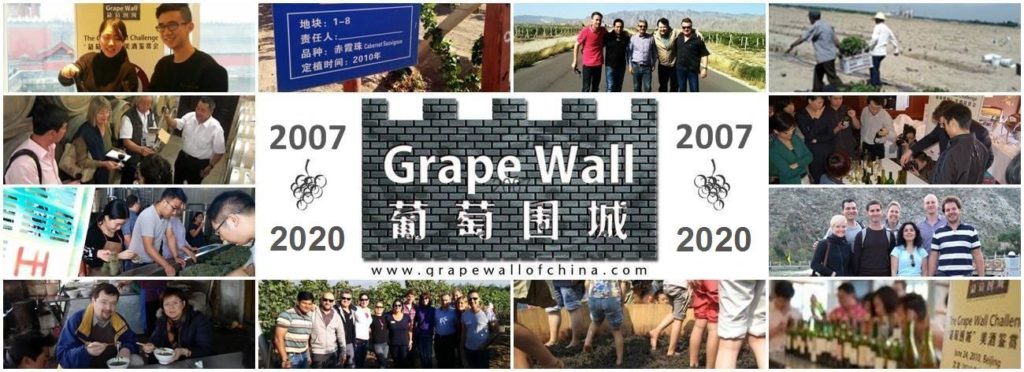
Grape Wall has no sponsors of advertisers: if you find the content and projects like World Marselan Day worthwhile, please help cover the costs via PayPal, WeChat or Alipay.
Sign up for the free Grape Wall newsletter here. Follow Grape Wall on LinkedIn, Instagram, Facebook and Twitter. And contact Grape Wall via grapewallofchina (at) gmail.com.

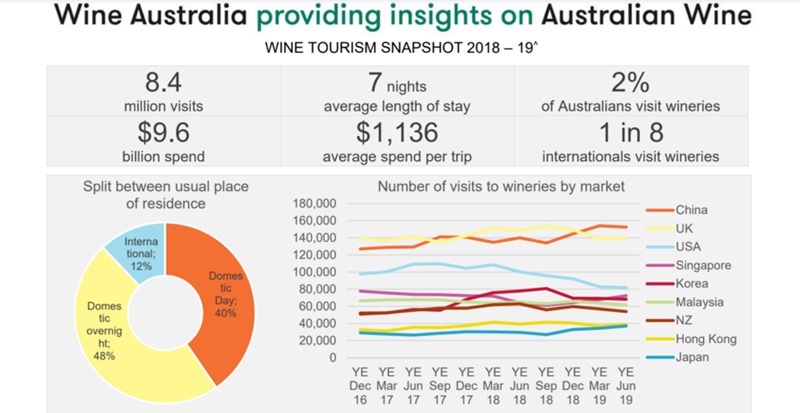
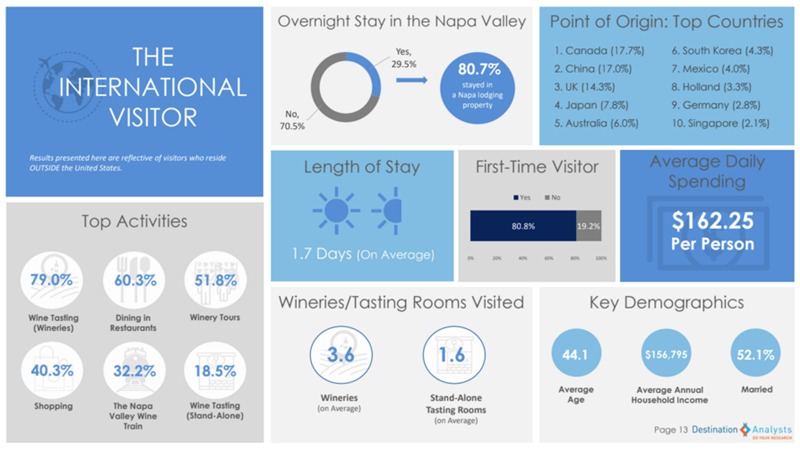


Leave a Reply
You must be logged in to post a comment.